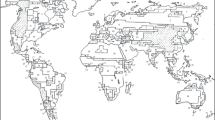Summary
A processing system consisting of 11 programs, designed for management and analysis of vegetation data is presented. The concept of the system and the operational logic are discussed. Some of the main features are detailed. These includs: (1.) availability of many methods, (2.) the possibility for the user to interact with the processing system by altering the analysis through options, and (3.) the computer supported handling of data, such as storing and retricving data, subdividing or combining data sets, reducing the number of species or relevés, and printing tables and graphs. Differences between this and other program packages are discussed. It is shown that the data, not only the programs, can be made a part of the processing system.
Similar content being viewed by others
References
Ceška, A. & H. Roemer. 1976: Ceška-Roemer Program for Identifying Species-Relevé Groups, Manuscript. 14 pp.
Dale, M.B. & L., Quadraccia. 1973. Computer assisted tabular sorting of phytosociological data. Vegetatio 28: 57–73.
Holzner, W. & F., Stockinger. 1973. Der Einsatz von Elektronenrechnern bei der pflanzensoziologischen Tabellenarbeit. Oesterr. Bot. Z. 121: 303–309.
Holzner, W., M.J.A., Werger & G.A., Ellenbroek. 1978. Automatic classification of phytosociological data on the basis of species groups. Vegetatio 38: 157–164.
Lieth, H. & G.W., Moore. 1971. Computerized clustering of species in phytosociological tables and its utilization for field work. In: G.P., Patil, E.C., Pielou & W.E., Waters (eds.), Statistical Ecology, Vol. 1, p. 403–422. London, Fenn. State Univ. Press.
Louppen, J.M.W. & E.van der, Maarel. 1979. Clusla. Vegetatio 40: 107–115.
Maarel, E.van der. 1979. Transformation of cover-abundance data Vegetatio 39: 97–115.
Maarel, E.van der, J.G.M., Janssen & J.M.W., Louppen. 1978. TABORD, a program for structuring phytosociological tables. Vegetatio 38: 143–156.
Orlóci, L. 1978 Multivariate analysis in vegetation research. Junk, The Hague, 2nd ed., 451 pp.
Orlóci, L. 1980. An algorithm for predistive erdination. In: E. van der Maarel (ed.). Advances in vegetation science: Classification and ordination Vegetatio 42: 000-000.
Spatz, G. & J., Siegmund. 1973. Eine Methode zur tabellarischen Ordination, Klassifikation und ökologischen Auswertung von pflanzensoziologischen Bestandesaufnahmen durch den Computer. Vegetatio 28: 1–17.
Streng, R. & Schönfelder. 1978. Ein heuristisches Computer-Programm zur Ordnung pflanzensoziologischer Tabellen. Hoppea, Denkschr, Regensb. Bot. Ges. 37: 407–433.
Wedekind, H., 1972. Datenorganisation. Walter de Gruyter, Berlin, New York. 2. Aufl. 271 pp.
Wildi, O., P.H. Fewster & L. Orlóci, 1978: Management and multivariate analysis of large data sets in vegetation research. Manuscript. London, Ont., Canada.
Author information
Authors and Affiliations
Additional information
A detailed introduction with a description of the processing system described in this paper is available from the author at no cost.
Rights and permissions
About this article
Cite this article
Wildi, O. Management and multivariate analysis of large data sets in vegetation research. Vegetatio 42, 175–180 (1980). https://doi.org/10.1007/BF00048884
Accepted:
Issue Date:
DOI: https://doi.org/10.1007/BF00048884




